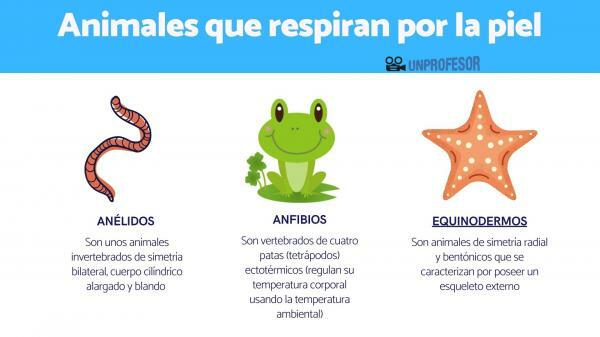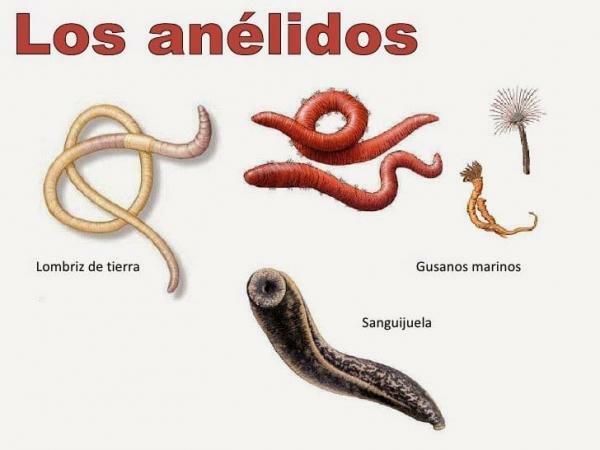ANIMALS that breathe through the skin

The breathing is the process in which organisms obtain the oxygen necessary for cells to carry carry out all its metabolic processes, and carbon dioxide from these processes is expelled. This respiration can take place through the lungs (pulmonary respiration), the gills (gill respiration), or the skin (cutaneous respiration). In this lesson from a TEACHER we review what are the skin-breathing animals. Join us!
Index
- What is skin respiration?
- Annelids, one of the animals that breathe through skin
- Amphibians
- Echinoderms
What is skin respiration?
In the skin respiration, the gas exchange process takes place through the skin. In order for it to be possible to breathe through the skin, it must be very thin, kept moist on the outside and well irrigated on the inside (gas exchange takes place with the blood). The fact that the skin must be damp on the outside, it limits animals that have skin respiration to live in semi-aquatic or humid environments.
The process is developed starting with the skin, through which the diffusion of oxygen into the blood vessels in its internal area, and carbon dioxide in reverse. Through these blood vessels, oxygen manages to reach the body's organs and cross the cell membrane of the cells that compose it. It is understood then why the skin of these animals must be thin.
Due to moisture needs, skin-breathing animals are primarily annelids, amphibians and echinoderms.

Annelids, one of the animals that breathe through the skin.
Annelids are a Invertebrate animals of bilateral symmetry, elongated and soft cylindrical body and of bilateral symmetry. Among them there are terrestrial, freshwater and marine animals. Among those who breathe through the skin are the following.
Earthworm
In worms, oxygen dissolves in the mucus that covers the skin and diffuses through it, then passes into the blood and is transported to the cells. It is estimated that there are between 4,000 and 6,000 species of earthworms.
Leeches
Leeches are worms that measure between 1 and 50 cm and live in fresh water, feeding on the blood of mammals. Formerly, it was used for medicinal purposes and even today some of these uses persist in some places. This species of worms does not have a well-differentiated respiratory system, which is why they exchange gases through their skin.

Image: Dictionary of GeoTecnia
Amphibians
The amphibians They are another of the animals that breathe through the skin. Are vertebrates Four-legged (tetrapods) ectothermic (regulate their body temperature using ambient temperature. Amphibians suffer a metamorphosis throughout your life, changing your breathing between different phases. Thus, in larval stages, they combine gill respiration with cutaneous respiration, while in adults they have pulmonary respiration. Among those that have phases with cutaneous respiration are the following.
Toads
They are a species of anuran amphibians (they do not have a tail). Although they are sometimes confused with frogs, they differ from them in that they are heavier, more robust and often move by walking and not jumping (although not always). They also have poisonous glands for defense against predators. Like other amphibians, they have skin and gill respiration when they are tadpoles, and lung as adults.
Frogs
Other amphibians of the order of the anurans that inhabit the water or in its vicinity. They have smoother skin than toads, they are more agile and have a more stylized body. Another difference with toads is their long legs that help them to make quick and precise jumps. As tadpoles, they have gill respiration and as adults they combine pulmonary with cutaneous respiration.

Echinoderms.
Echinoderms are animals of radial symmetry and benthic (inhabitants of the bottom of aquatic ecosystems) and characterized by having an external skeleton (dermoskeleton) or an internal skeleton formed by plates articulated between them. Among those who breathe through the skin are the following.
Sea urchins
It is an echinoderm with a flattened spherical shape and spiny skin that inhabit the seabed. Its external calcareous plates form a kind of shell and are articulated with mobile spikes that serve to move them. While most sea urchins breathe through gills, some species have skin respiration. About 950 species of hedgehogs are known.
Sea stars
These echinoderms belong to the class of asteroids, they have a radial structure with between 5 and 50 arms and they inhabit all oceans, both cold and tropical. They have a hydraulic skeleton that allows them to move. They capture oxygen by diffusion through the skin. Between 1,500 and 2,000 species of starfish are known worldwide.
Sea cucumber
Echinoderm with a long, soft body and without limbs. It has a size that varies between a millimeter and several meters. While most sea cucumbers breathe through the skin, some species have a tube near their anus that allows them to breathe.

Image: La Chachipedia
If you want to read more articles similar to Animals that breathe through skin, we recommend that you enter our category of biology.
Bibliography
Hickman, C. P. (2009). Comprehensive principles of zoology (14a. ed. --.). Madrid: McGraw-Hill.


